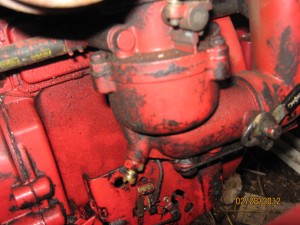Skill
Moderately Challenging
Things You’ll Need
Carburetor rebuild kit
Service manual
Mechanic’s tool set
Cleaning solvent
Air compressor
Introduction
At first glance, rebuilding your small engine carburetor looks like a daunting task. However, most backyard mechanics with moderate mechanical skills – along with attention to detail– will be able to tackle this job. Yard and garden tractor carburetors are relatively simple compared to fuel injection systems or even automotive carburetors. Most styles of carburetors share similar features. However, each make and model of garden equipment is different and has its own set of specifications. No single reference can cover in detail all the differences therefore; you must have a service manual covering your engine model.
Removing the Carburetor
Step 1
Disconnect the battery cable if equiped. Close off the fuel valve between the gas tank and the carburetor. Use a spray can of carburetor cleaning solvent to clean off grease and oil deposits from the area near the carburetor. Take care not to spray the solvent onto plastic parts. Remove the choke cable, throttle cable, governor linkage and air cleaner. If equipped, disconnect the fuel shut-off solenoid. Unbolt the carburetor from the intake manifold and lift it away from the engine.
Step 2
The carburetor will still contain gasoline inside the float bowl so it remains highly combustible; handle it with care. Take notes during disassembly in case a question arises concerning how the parts fit during reassembly. Clean off outside surfaces using carburetor cleaning solvent taking care to protect plastic parts.
Step 3
Gently screw in the idle adjustment screw and main jet screw all the way in; count the number of turns. Record the number of turns in your notes; this will give you a starting point for adjustment after reassembly.
Step 4
Note the orientation of the parts as you remove them. Do not throw away any parts until you finish rebuilding and the engine is running properly. Because some rebuild kits contain extra parts—some of them closely resembling one another–you may need the old parts for comparison. Inspect all parts for wear, some parts may not be included in the rebuild kit; you will have to purchase those replacement parts separately.
Disassembly and Cleaning the Carburetor
Step 1
Loosen the screws securing the top and bottom halves of the carburetor. Separate the top half. Empty the gasoline from the float bowl into a safe container for proper disposal. Refer to the service manual during disassembly to avoid damage to the carburetor. Take apart the brass float and needle valve assembly. Remove the idle jet screw and main jet by unscrewing them all the way out. Remove the throttle valve and choke valve.
Step 2
Remove all Welch plugs by piercing them with a small, sharp punch taking care not to nick the carburetor body underneath. Remove other parts as instructed in the service manual.
Step 3
Soak all of the parts in carburetor cleaning solvent for about 12 hours. Check the service manual to make sure it is safe to soak plastic parts.
Step 4
Remove the parts from the cleaning solvent and thoroughly rinse them with clean warm water to halt the corrosive action of the solvent. Blow-dry the parts with compressed air.
Step 5
Clean all exposed orifices — including those under the Welch plugs – with solvent and compressed air. Never use wire to clean orifices. Wire will enlarge the orifice diameter and cause damage to the carburetor.
Reassembly and Re-installation
Step 1
Install new Welch plugs using the end of a wooden dowel of the same diameter as the plug. Position the plug over its opening, and then align the dowel on the plug. Gently tap dowel with a hammer driving the plug into place until it is flat — not pushed in below the surface of the carburetor body. Seal the plug with a fuel-resistant sealer. Fingernail polish makes a good substitute sealer.
Step 2
Install and adjust the new parts from the rebuild kit as indicated in the service manual. Check the float level; adjust if necessary. Reinstall old parts in good condition not included in the kit. Place a small drop of thread lock on the throttle plate and choke plate retaining screws.
Step 3
Screw both halves of the carburetor back together making sure the gasket is in proper position.
Step 4
Clean the area around the intake manifold. Bolt the carburetor with its gasket back onto the intake manifold. Reconnect the choke cable, throttle cable and governor linkage. Clean and reinstall the air cleaner. Reconnect the fuel shut off solenoid if equipped.
Step 5
Refer back to your notes to determine how far in the idle and main jet adjustment screws need to be turned. Turn the adjustment screws all the way in then back them out the required number of turns.
Step 6
Reconnect the fuel line and turn on the fuel valve. Reconnect the battery cable.
Step 7
Make the final carburetor adjustment as indicated in the service manual.
Tips
Your local public library will have service manuals available for loan.
Rebuilding a small engine carburetor is like putting together a puzzle. It takes time and all of the pieces must fit before it is finished.
Bob
